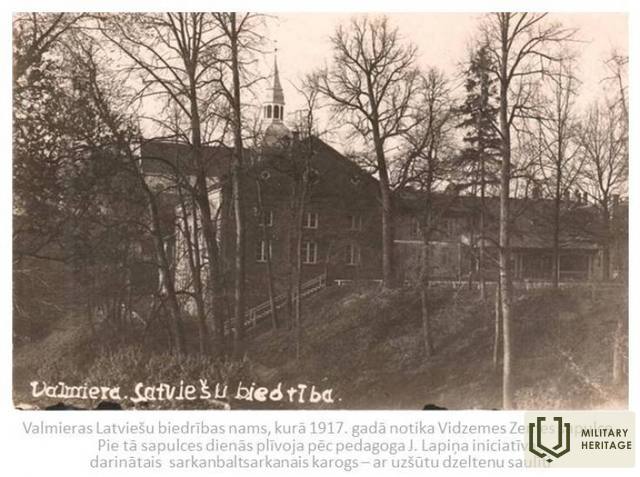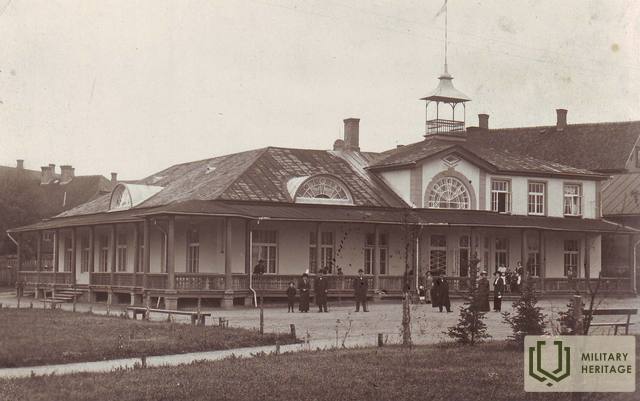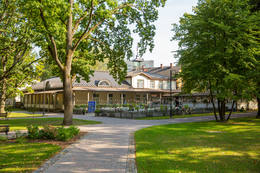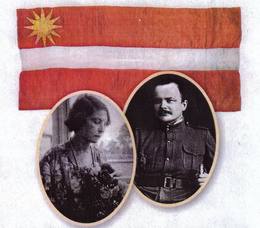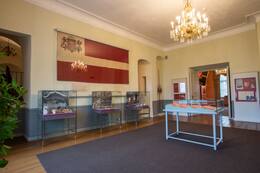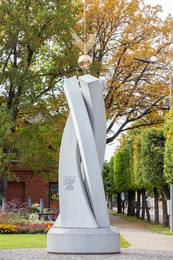1917 m. kovas – svarbus mėnuo Valmieros ir Latvijos istorijoje
1917 m. kovo mėn., likus daugiau nei metams iki Latvijos valstybės paskelbimo, Valmieroje buvo įkurta Vidžemės laikinoji žemės taryba, kuri priėmė rezoliuciją dėl Latvijos autonomijos ir apsisprendimo teisių. Tarybos įkūrimo dieną posėdžių vietoje pirmą kartą buvo iškelta raudonai baltai raudona vėliava.
1917 m. kovo 12 ir 13 d. (kovo 25, 26 d.) įvyko Vidžemės žemės susirinkimas. Valmieroje susirinko Rygos, Cėsių, Valmieros ir Valkos rajonų savivaldybių, kooperatinių asociacijų, žemės ūkio draugijų ir bežemių atstovai. Nors darbotvarkėje buvo ir politinių, ir ekonominių klausimų, tikroji susirinkimo užduotis buvo įsteigti Vidžemės laikinąją žemės tarybą. Pagrindinis kalbėtojas agronomas Kārlis Ulmanis pabrėžė ateityje siektinus politinius tikslus. Buvo priimta 17 rezoliucijų, iš kurių svarbiausia – dėl Latvijos autonomijos ir apsisprendimo teisių.
Nepraėjus nė dvejiems metams, 1918 m. lapkričio 17 d. vakarą Rygoje, viešbutyje „Suvorovas“, buvo suformuota Latvijos Liaudies Taryba ir išrinktas Latvijos Laikinosios Vyriausybės ministras pirmininkas Kārlis Ulmanis. Liaudies Taryba nusprendė Latvijos valstybės paskelbimo aktą atlikti Latvijos operos teatre (dabar Latvijos nacionalinis teatras).
Jau kitą dieną, 1918 m. lapkričio 18 d., Valmieroje dr. Georgas Apinis paprašė vokiečių okupacinės valdžios leidimo surengti Valmieros sporto asociacijos visuotinį susirinkimą Senųjų berniukų parko paviljono salėje. G. Apinio bendražygiai, žinodami tikruosius jo ketinimus, slapta pagamino raudonai baltą ir raudoną vėliavą, atkūrė tekstus „Dieve, laimink Latviją“ ir pristatė juos Senųjų berniukų parko paviljono salėje. Dr. G. Apinis susirinkusiems paskelbė šios dienos istorinę reikšmę, o dalyviai iškilmingai pasižadėjo remti naująją valstybę ir jos Laikinąją vyriausybę, vadovaujamą Kārlio Ulmanio. Šią dieną Valmieroje pirmą kartą buvo iškelta nacionalinė vėliava kaip valstybinė vėliava ir pirmą kartą sugiedotas naujasis himnas „Dieve, laimink Latviją“.
Įdomu tai, kad valmieriečiai buvo vieni pirmųjų, sužinojusių apie Latvijos valstybės įkūrimą. Dieną prieš tai apie tai buvo žinoma ir Valmieros realinėje mokykloje, ką liudija 1918 m. lapkričio 18 d. mokinio dienoraščio įrašas – „Dėl Latvijos valstybės paskelbimo paskutinės trys pamokos neįvyks.“ Lapkričio 18 d. Valmieros realinės mokyklos mokiniai taip pat nusifotografavo su raudonais, baltais ir raudonais kaspinais priešais mokyklą.
Šaltinis: Valmieros muziejaus istorijos skyrius
Susijusi laiko juosta
Susijusios temos
Susijusios vietos
Elnparkas ir koncertų salė „Valmiera“
Parkas yra Valmieros centre.
1914 metais aštuoni verslūs Valmieros gyventojai nusprendė tuo metu miesto pakraštyje įkurti parką su nealkoholinių gėrimų bufetu ir knygų stalu – taip prasidėjo Vecpuišių parko istorija.
Parko plėtros darbus nutraukė Pirmasis pasaulinis karas.
Jau karo pradžioje paviljono salėje buvo įkurta sužeistų kareivių ligoninė. Antrajame pastato aukšte buvo įsikūręs Valmieros Raudonojo Kryžiaus komitetas, jo centrinis aukų priėmimo punktas ir sandėlis.
Valmieros komitetas buvo vienas aktyviausių Latvijoje. 1914 m. spalį jis vadovavo 33 ligoninėms su 375 lovomis. Komitetas rinko lėšas ligoninių išlaikymui ir sužeistų kareivių gydymui, šiltų patalynės ir kelionės pinigų tiekimui pasveikusiems, sužeistų kareivių maitinimui, taip pat siuntė dovanas tiesiai į frontą. Vienas aktyviausių Raudonojo Kryžiaus komiteto darbuotojų, rinkusių lėšas, buvo Kārlis Ulmanis (1877–1942), vėliau tapęs pirmuoju nepriklausomos Latvijos ministru pirmininku.
Su Vecpuišių parku taip pat susijusi legendinių Latvijos šaulių batalionų įkūrimo istorija. 1915 m. rugpjūčio 4 ir 5 d. parke veikė savanorių verbavimo komitetas, o rugpjūčio 6 d. iš čia į mokymus buvo vežami jauni kareiviai. Vėliau iš čia į kareivius ne kartą buvo vežami ir jauni vyrai iš Valmieros bei apylinkių. Karo metu parke taip pat vykdavo įvairūs kultūros ir labdaros renginiai, tačiau visos surinktos lėšos buvo skirtos padėti nukentėjusiesiems nuo karo.
1918 m. lapkričio 18 d. Valmieroje pirmą kartą buvo iškelta tautinė vėliava kaip valstybės vėliava ir pirmą kartą sugiedotas naujasis himnas „Dieve, laimink Latviją“.
Antrojo pasaulinio karo metu Vecpuišų parko paviljono pastate buvo įrengta ligoninė, o šauliai buvo vedami į mūšius. Sovietų okupacijos metu, 1940 m. rugpjūčio 12 d., Valmieros miesto valdybos sprendimu parkas buvo pervadintas į Komjaunimo parką.
Po Antrojo pasaulinio karo architekto Freibergo suprojektuotas paviljonas buvo naudojamas ir kaip kultūros centras (iki 1966 m.), ir kaip sporto mokykla. Dešimtojo dešimtmečio pabaigoje (1998 m.) paviljonas Bakalauro parke vėl pradėjo veikti.
Restorano „Vecpuisis“ patalpose eksponuojamose nuotraukose įamžinti parko įkūrėjai.
J. Lapinio, pirmosios Latvijos vėliavos autoriaus, atminimo vieta
Įsikūręs „Lejas Pintuliai“, Veselavos valsčiuje, Priekulių savivaldybėje.
Matomas paminklas Latvijos vėliavos autoriui Jāniui Lapiniui.
Latvijos nacionalinė vėliava buvo sukurta Pirmojo pasaulinio karo metu. 1915 m., kuriant Latvijos šaulių batalionų vėliavas, pavieniai menininkai siūlė raudonas, baltas ir raudonas vėliavų spalvas. Po pedagogo ir žurnalisto Janio Lapinio sumanymo raudonai baltai raudoną vėliavą 1916 m. antroje pusėje pagamino jo mokinė Marianna Straumane, Valmieros pabėgėlių prieglaudos mokytoja.
Tai pirmoji žinoma ir iš tikrųjų pagaminta Latvijos nacionalinė vėliava, išlikusi iki šių dienų.
2014 m. Priekulių rajono Veselavos valsčiaus „Lejas Pintuļi“ buvo atidaryta atminimo vieta prieš vėliavą autoriui Jāniui Lapinui.
Pirmoji žinoma autentiška Latvijos nacionalinė vėliava, kuri buvo slapta įvežta į Rusiją ir kruopščiai paslėpta sovietų ir vokiečių okupacijų metu, šiuo metu saugoma Cėsių istorijos ir meno muziejuje . Ją 1997 m. padovanojo jų dukra Lija Poga.
Cėsių istorijos ir meno muziejus Cėsių Naujojoje pilyje
Cėsių istorijos ir meno muziejus yra įsikūręs pačiame Cėsių senamiesčio centre, Naujojoje pilyje. Muziejuje veikia nuolatinė istorijos ir interjero ekspozicija „Cėsys – Latvijos istorijos simbolis“, kurią sudaro du teminiai skyriai: ekspozicija „Raudona-balta-raudona vėliava Cėsių ir Latvijos istorijoje“ aiškina Latvijos nacionalinės vėliavos istoriją nuo XIII iki XX a., patvirtintą nacionalinį simbolį, Latvijos šaulių batalionų vėliavas ir nacionalinių spalvų naudojimo tradicijas Latvijos nepriklausomybės karo metu. Parodoje „Cėsys ir Latvijos nepriklausomybės karas“ daugiausia dėmesio skiriama Cėsių kuopos įkūrimui 1918 m. gruodžio mėn., bendroms estų ir latvių kovos pastangoms 1919 m. Cėsių mūšiuose, laikui, kai Bermonto aferos metu Cėsys trumpą laiką buvo laikinoji Latvijos sostinė, taip pat Cėsių pergalės paminklo istorijai. Pabėgimo kambaryje „Cėsių mūšių legendos“ dalyviai turi valandą rasti išeitį spręsdami galvosūkius, užmegzdami ryšius ir ieškodami paslėptų daiktų. Cėsių kuopa, vienas pirmųjų Latvijos ginkluotųjų pajėgų dalinių, buvo įkurta 1918 m. gruodžio 8 d. Cėsių pilyje vyresniojo leitenanto Artūrs Jansons. Muziejaus ekspozicijoje eksponuojama Cėsių kuopai skirta atminimo lenta, atidengta 1933 m. gruodžio 8 d. Cėsių Naujojoje pilyje, kuri tuo metu buvo 8-ojo Daugpilio pėstininkų pulko ir garnizono karininkų klubo štabas.
Paminklas „Atidavimas Latvijos Laikinajai Nacionalinei Tarybai“
Paminklas „Atidavimas Latvijos laikinajai nacionalinei tarybai“ yra Valkoje, Rygos ir Rainės gatvių sankryžoje (adresas Rainės gatvė 9A).
Paminklas buvo atidengtas 2017 m. gruodžio 2 d., kaip Latvijos šimtmečio programos dalis, pagerbiant 1917 m. vykusį Latvijos Laikinosios Nacionalinės Tarybos posėdį.
Ansamblio idėjos autorė – skulptorė Arta Dumpė, akmenkalys – Ivaras Feldbergas, architektūrinį planavimą atliko SIA „Architektūros biuras Vecumnieks & Bērziņi“.
Paminklo pagrindą sudaro didelis girnapusė – tarsi gyvenimo, laiko ir įvykių ratas. Jo šonuose iškalti LPNP valdybos narių vardai ir pavardės. Iš girnapusės, tarsi likimo takai, į dangų kyla trys regionai – Vidžemė, Kuržemė ir Latgala su savo istoriniais herbais. Kompoziciją užbaigia Betliejaus žvaigždė, kuri virsta naujosios Latvijos valstybės saule. Latvių poetas, prozininkas ir politikas Kārlis Skalbe /1879–1945/ rašė: „Latvija irgi turėjo savo Betliejų, mažoji vargšė Valka...“.
Latvijos laikinosios nacionalinės tarybos paminklas yra savotiška skolos grąžinimo forma žmonėms, kurie 1917 m. Valkoje, rizikuodami savo gyvybėmis, vedami idealų, praktiškai beviltiškoje situacijoje padėjo Latvijos valstybės pamatus.
Tuo metu Valka buvo miestas su didžiausia latvių populiacija teritorijoje, kurios dar neokupavo Vokietija. Po Rygos žlugimo ji tapo Latvijos socialinio, politinio ir kultūrinio gyvenimo centru. Čia rinkdavosi tie, kuriuos vienijo noras įgyvendinti latvių tautos apsisprendimo teisę. Nuo 1917 m. lapkričio 29 d. iki gruodžio 2 d. (pagal naująjį stilių) Valkos miesto rotušėje (dabar pastatas Kesk gatvėje Nr. 11 Valgoje) vyko pirmoji Latvijos laikinosios nacionalinės tarybos sesija, kurioje dalyvavo beveik visų įtakingiausių Latvijos visuomeninių organizacijų ir politinių partijų atstovai. Pirmą kartą jie oficialiai paskelbė savo veiklos tikslą – nepriklausomos nacionalinės valstybės sukūrimą – ir priėmė deklaraciją dėl vieningos ir autonominės Latvijos sukūrimo Latvijos Vidžemės, Kuržemės ir Latgalos rajonuose.




